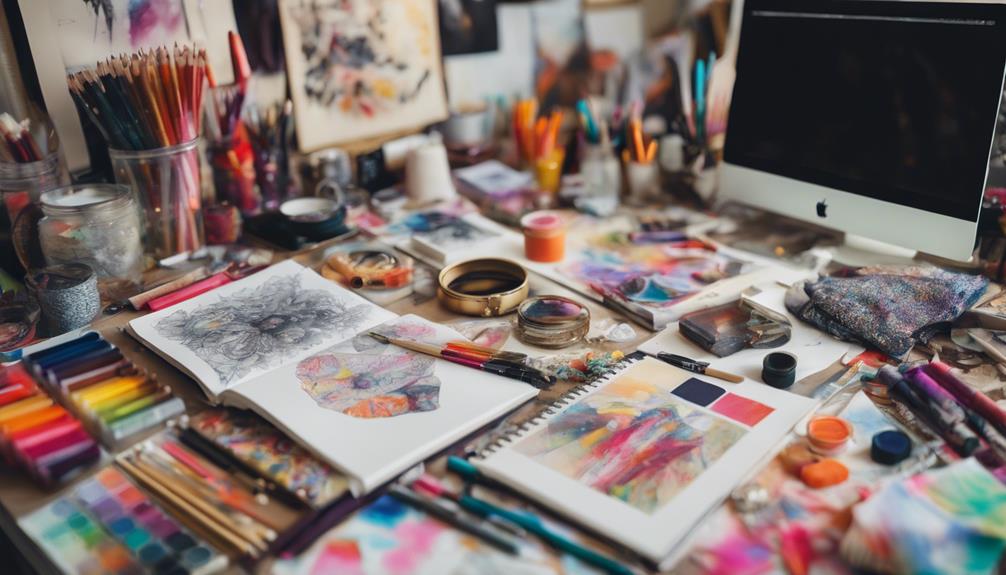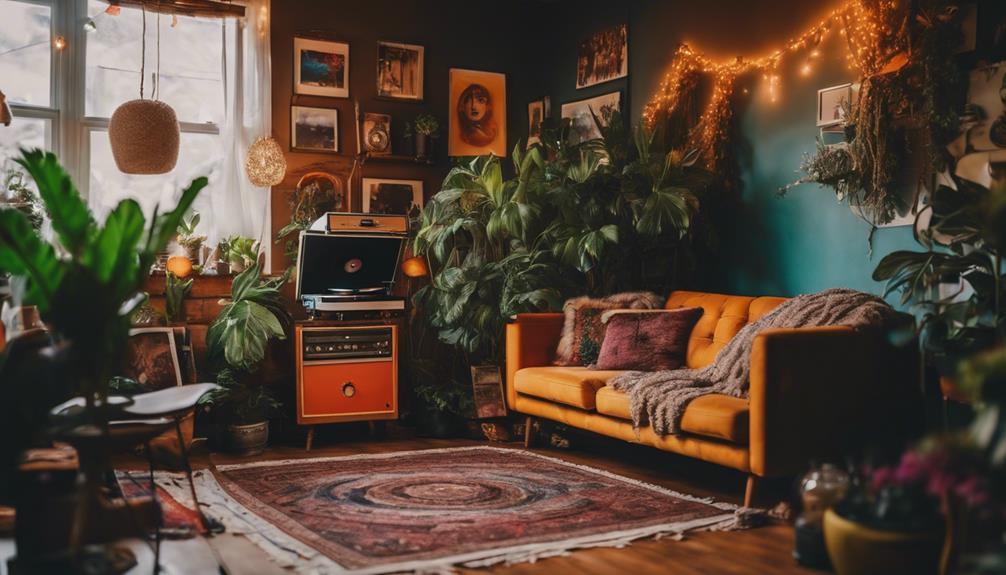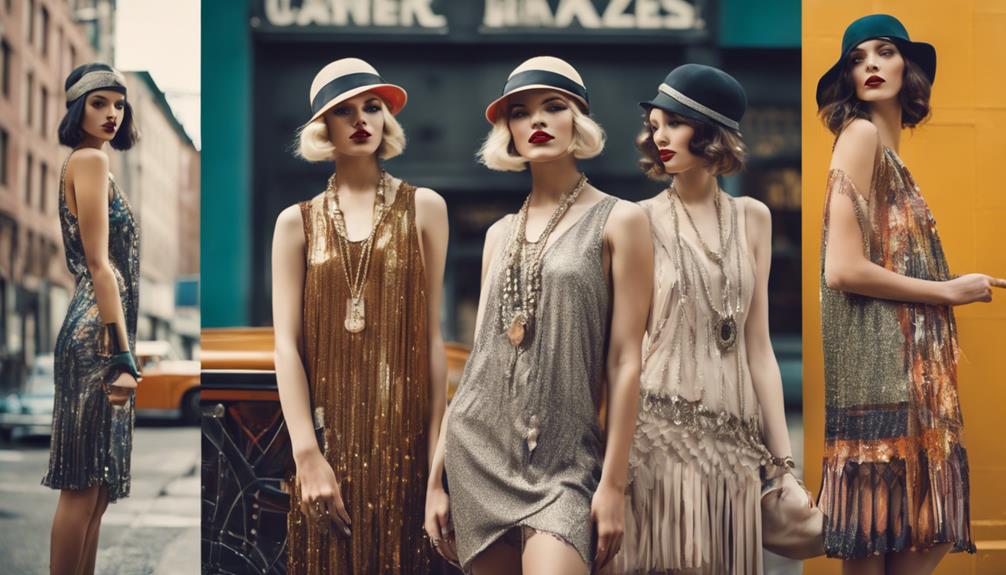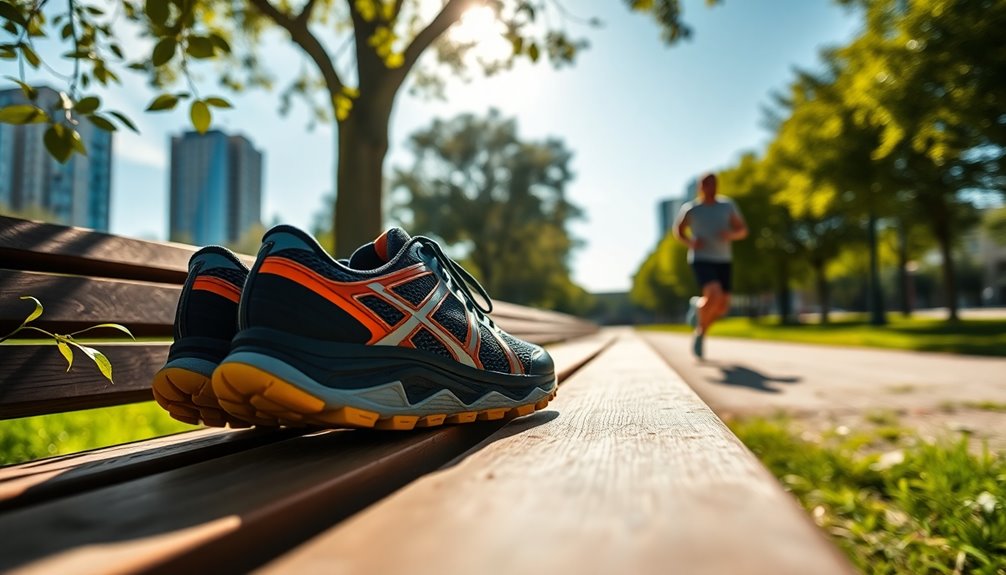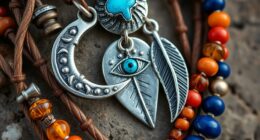Fashion sketches are the key to unlocking your inner designer! They allow you to delve into unique aesthetics and showcase your creativity. By perfecting different silhouettes and vibrant fabrics, you can bring your ideas to life visually. Today’s fashion promotes sustainability and inclusivity, giving your sketches not only artistic value but also deeper meaning. Experiment with various styles, layering techniques, and color schemes to truly represent your personality. Stock up on the right sketching materials and don’t hesitate to upcycle old clothing for fresh inspiration. There is so much to explore in this captivating craft, so don’t stop now – keep discovering more!
Key Takeaways
- Fashion sketches allow designers to express their creativity and visualize unique garment ideas before production.
- Signature silhouettes and distinctive lines in sketches convey movement and the essence of the designs.
- Incorporating vibrant textiles and patterns energizes sketches, reflecting current trends and cultural influences.
- Timeless statement garments in sketches emphasize quality materials and functional designs for sustainable fashion.
Origin and historical background of the fashion trend/style
When you explore the origins of fashion sketches, you'll notice how historical shifts have shaped the way we see style today.
Icons and trends from past eras have influenced modern designers, creating a rich tapestry of creativity.
Understanding this evolution helps you appreciate the art of fashion sketching and its role in the industry.
Historical Fashion Shifts
Fashion has always mirrored society's evolving values and norms, with each historical shift reflecting the cultural and political landscapes of its time. These historical fashion shifts have notably influenced fashion designs, shaping how people express themselves through clothing.
During the Renaissance, opulence and artistry flourished, while the Industrial Revolution introduced mass production, making fashion more accessible.
The flapper style of the 1920s marked a pivotal moment, as women embraced a relaxed silhouette that represented newfound freedoms after World War I. Fast forward to the 1960s, and youth culture ignited bold designs, with icons like Mary Quant popularizing the miniskirt and mod fashion, symbolizing rebellion and change.
The 1980s brought extravagance, with power dressing and vibrant colors reflecting an era focused on wealth and success, as seen in the works of designers like Thierry Mugler and Gianni Versace.
Now, as we enter the 21st century, there's a notable shift towards sustainability and inclusivity, emphasizing ethical practices and diverse representations in fashion designs.
Understanding these historical fashion shifts allows you to appreciate the depth and significance behind the trends you love today.
Fashion Icons and Trends
Throughout history, iconic figures like Coco Chanel and Audrey Hepburn have shaped fashion trends, introducing revolutionary styles that transformed women's clothing and self-expression. Chanel's flapper style in the 1920s marked a pivotal shift, emphasizing short hemlines and boyish silhouettes. This change symbolized women's newfound independence post-World War I, and fashion illustrations from that era captured the essence of liberation and modernity.
As you move through the decades, you'll notice the 1960s brought the Mod fashion wave, led by icons like Twiggy and Mary Quant. They embraced bold patterns and mini skirts, reflecting the youthful spirit of a cultural revolution.
Fast forward to the 1980s, and power-dressing emerged, with tailored suits and bold accessories championed by figures like Diana Vreeland, emphasizing women's authority in the corporate world.
The 1990s introduced grunge fashion, popularized by musicians like Kurt Cobain. This laid-back aesthetic, characterized by flannel shirts and ripped jeans, challenged conventional norms.
Each of these trends is immortalized in fashion illustrations, showcasing how iconic figures influenced styles that resonate even today. Embrace these influences as you sketch your unique designs!
Key Characteristics
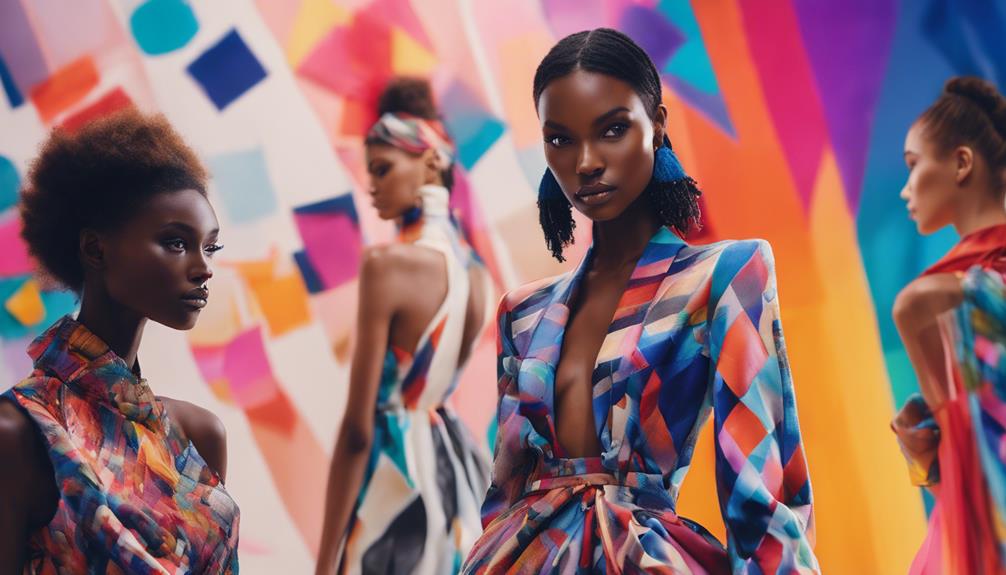
When you create fashion sketches, you'll notice the importance of signature silhouettes and lines that define each piece.
Incorporating vibrant textiles and patterns adds depth and excitement, while timeless statement garments guarantee your designs resonate with style.
Let's explore these key characteristics that make your sketches stand out.
Signature Silhouettes and Lines
Designers often rely on signature silhouettes and distinctive lines to convey their unique aesthetic and create memorable garments. When sketching, you'll find that signature silhouettes, like A-line, hourglass, and straight-cut, emphasize distinct shapes that reflect your style. Each silhouette communicates not just form but also attitude, capturing your vision in a visually compelling way.
Lines play a significant role too. Whether they're fluid and curvaceous or sharp and angular, the lines you choose define how a garment moves and drapes on the body. Think about how a bold, straight line can evoke a sense of modernity, while a soft, curved line might suggest femininity and grace.
In your sketches, exaggerating proportions—like drawing croquis figures 8 to 11 heads tall—allows you to dynamically represent these silhouettes. Additionally, varying line weight and texture can indicate fabric qualities, adding depth to your designs.
Vibrant Textiles and Patterns
Building on the foundation of signature silhouettes and lines, vibrant textiles and patterns bring garments to life with their bold colors and intricate designs. When you incorporate vibrant textiles into your creations, you're not just adding fabric; you're infusing personality and energy. These textiles often feature high-contrast color combinations that evoke strong emotional responses, making them perfect for statement pieces that demand attention.
You can explore various pattern types, including geometric shapes, florals, and abstract designs. Each pattern can express different styles and moods, allowing you to tailor your designs to your vision. Cultural influences also play a significant role in the vibrant patterns you choose, with traditional motifs providing a rich source of inspiration for contemporary textile designs.
Thanks to advances in digital printing technology, you can create more complex and vivid patterns than ever before. This innovation not only enhances your creativity but also allows for greater customization in your fashion designs. So, don't shy away from experimenting with vibrant textiles. They can transform your sketches into eye-catching pieces that truly stand out.
Timeless Statement Garments
Timeless statement garments embody classic silhouettes and high-quality materials that guarantee they remain stylish and versatile throughout the years. Think of pieces like the A-line dress or tailored blazer, which have consistently flattered various body types and adapted to different occasions. By investing in these garments, you're affirming your wardrobe stays relevant and functional.
High-quality materials such as wool, silk, and cotton are essential for these timeless pieces, providing durability and a luxurious touch that enhances their overall aesthetic. You'll often find a limited color palette in these garments, featuring neutral tones and primary colors that allow for effortless mixing and matching.
Iconic details, like structured shoulders and clean lines, add to the allure of timeless statement garments. These minimal embellishments affirm they're suitable for both casual outings and formal events.
When you embrace these classics in your fashion illustration or design sketches, you're tapping into a style that transcends fleeting trends. By focusing on functional design and effortless style, you can create wardrobe staples that will stand the test of time, keeping your fashion game strong for years to come.
Modern Interpretation
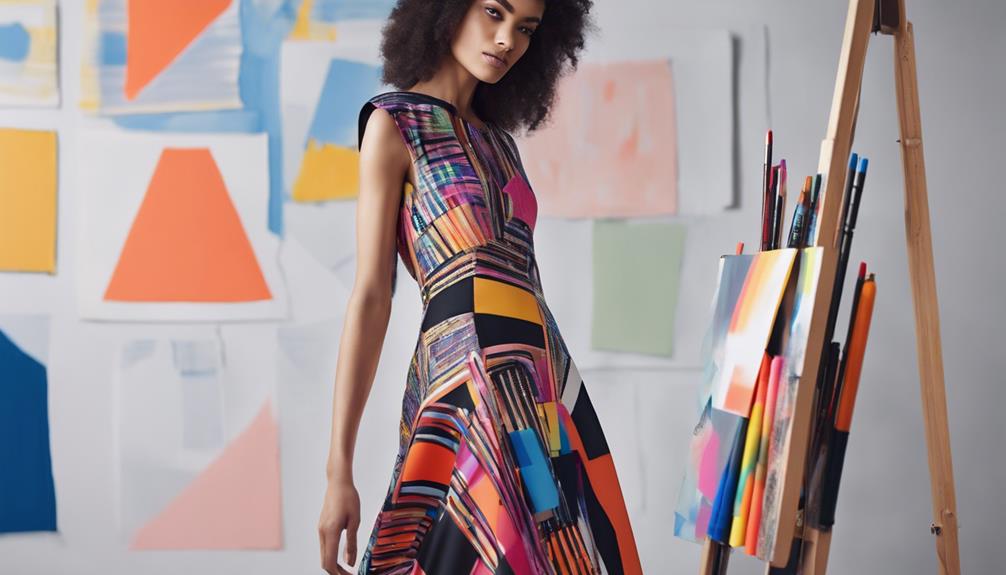
In today's fashion landscape, you're likely noticing a strong emphasis on sustainable innovations and labels that prioritize eco-friendly practices.
Social media influencers are shaping trends by showcasing these sustainable choices, making them more accessible and appealing to a broader audience.
As you explore modern fashion sketches, consider how these elements reflect a shift towards a more conscious and inclusive industry.
Sustainable Fashion Innovations
Sustainable fashion innovations are reshaping the industry by embracing eco-friendly materials and cutting-edge technologies that minimize waste. As you plunge into this domain, you'll notice brands increasingly adopting organic cotton, Tencel, and recycled fabrics to lessen their environmental impact. Not only are these materials kinder to the planet, but they also offer you unique design opportunities.
Additionally, the use of AI and data analytics in fashion design enhances production efficiency. This means you'll see less waste as fabric usage is optimized and consumer demand is accurately predicted. Many brands are even implementing closed-loop systems, recycling old garments into new textiles, which promotes circular fashion.
Technological advances like 3D knitting enable on-demand production, allowing you to create garments only as they're ordered. This drastically cuts down on overproduction, ensuring your designs meet actual demand.
Plus, the rise of digital fashion lets you engage with style without the environmental footprint associated with physical garment production. By embracing these sustainable fashion innovations, you're not just designing; you're contributing to a more responsible and innovative future in fashion.
Sustainable Fashion Labels
Emerging from the need for ethical practices, sustainable fashion labels are redefining style by prioritizing eco-friendly materials and transparent production processes. As a conscious consumer, you might be pleased to know that 66% of shoppers are willing to pay more for sustainable brands. This shift reflects a growing demand for clothing that respects both people and the planet.
Many sustainable fashion labels leverage innovative fabrics made from recycled materials, like plastic bottles and organic cotton, to considerably reduce environmental impact. Transparency is essential in this movement, with 73% of consumers seeking brands that clearly communicate their manufacturing practices.
You'll find that notable names, such as Stella McCartney and Eileen Fisher, are leading the charge by embracing circular economy principles. They promote recycling and repairing garments to extend their lifecycle, which not only reduces waste but also encourages a more mindful approach to fashion.
With the global sustainable fashion market projected to reach $8.25 billion by 2023, it's clear that sustainable fashion labels aren't just a trend; they're a key part of the future of fashion. Embracing these brands allows you to make stylish choices that have a positive impact.
Fashion-Forward Social Media Influencers
Fashion-forward social media influencers are reshaping the landscape of style, enchanting millions with their unique aesthetics and trendsetting content. These influencers leverage platforms like Instagram and TikTok to showcase their distinct looks, driving trends that often set the fashion agenda.
As a fashion illustrator, you can draw inspiration from their innovative styles and creative collaborations with brands, which often result in exclusive collections that captivate audiences. By analyzing engagement metrics through A/B testing, influencers optimize their content to enhance viewer interaction, sometimes achieving a staggering 50% increase in conversion rates.
The rise of these influencers has democratized fashion, celebrating diverse body types and aesthetics, which broadens the definition of beauty. This inclusivity resonates deeply with followers, making them feel represented in the fashion narrative.
Additionally, around 80% of consumers now prefer personalized shopping experiences, thanks to the tailored recommendations and styling advice influencers provide. As you sketch your fashion designs, consider how these influencers shape consumer preferences and trends.
Their impact is undeniable, and as you embrace your inner designer, you can utilize their insights to elevate your own creative expression in the fashion world.
Styling Tips
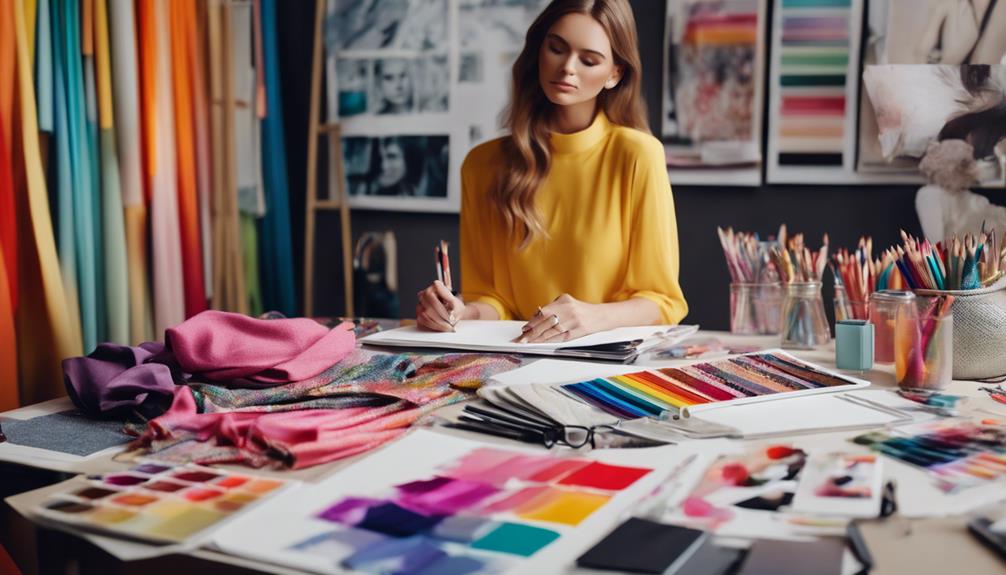
When it comes to styling your sketches, mastering the classic white button-up shirt is a game-changer.
You'll want to explore chic layering techniques that add depth and versatility to your designs.
Plus, don't forget about color coordination techniques; they can make or break your overall look.
Classic White Button-Up Shirt
The classic white button-up shirt is a must-have in your wardrobe, as it effortlessly shifts from casual to formal settings with the right styling. To truly express your inner fashion, consider how you can adapt this versatile piece for various occasions.
For a polished office look, pair the shirt with tailored trousers and heels. This combination radiates professionalism and confidence.
If you're aiming for a more relaxed vibe, tuck the shirt into high-waisted jeans. Accessorize with a statement belt to add flair, and layer with a lightweight cardigan for comfort. This look is perfect for weekend brunch or casual outings.
Don't forget the power of a blazer—throw one over your white button-up to instantly elevate your outfit. This is ideal for business meetings or evening events.
You can also experiment with different fabrics, like linen or cotton blends, to enhance the shirt's drape and comfort. This allows you to enjoy diverse styling options across seasons, ensuring your white button-up remains a staple no matter the occasion.
Embrace the versatility and let your creativity shine!
Chic Layering Techniques
Layering not only boosts your outfit's style quotient but also lets you play with textures and lengths to create a chic and personalized look.
Embrace chic layering techniques by starting with a base layer, like a fitted turtleneck or a simple tank top, then add varying lengths. Pair a long cardigan with a cropped top for visual interest and to flatter your figure. Mixing different fabrics, such as knits and silks, enhances comfort while introducing unique textures to your ensemble.
Don't forget about accessories! A statement belt can define your waist, while bold jewelry draws attention and elevates your outfit.
Consider using design ideas like layering a denim jacket over a flowy dress or adding a tailored blazer to a casual outfit for sophistication.
Color Coordination Techniques
Mastering color coordination techniques can transform your fashion sketches into visually enchanting designs that resonate with style and creativity.
Start by familiarizing yourself with the color wheel; understanding complementary, analogous, and triadic color schemes is essential. These techniques enhance the visual appeal of your sketches, ensuring a mesmerizing design.
Utilize the 60-30-10 rule for color distribution. This means 60% of your outfit should feature a dominant color, 30% a secondary color, and 10% an accent color. This approach creates a balanced, harmonious look that's easy on the eyes.
Don't forget to incorporate neutrals like black, white, and gray; these versatile bases allow bolder colors to shine.
Experimenting with various fabric textures in your sketches can also make a significant impact. The interplay of colors and textures adds depth, enriching your designs.
Finally, consider seasonal color palettes—like pastels for spring or jewel tones for autumn—to keep your fashion sketches trendy and aligned with consumer preferences.
Embrace these color coordination techniques to elevate your design game and free your inner designer!
Shopping Guide
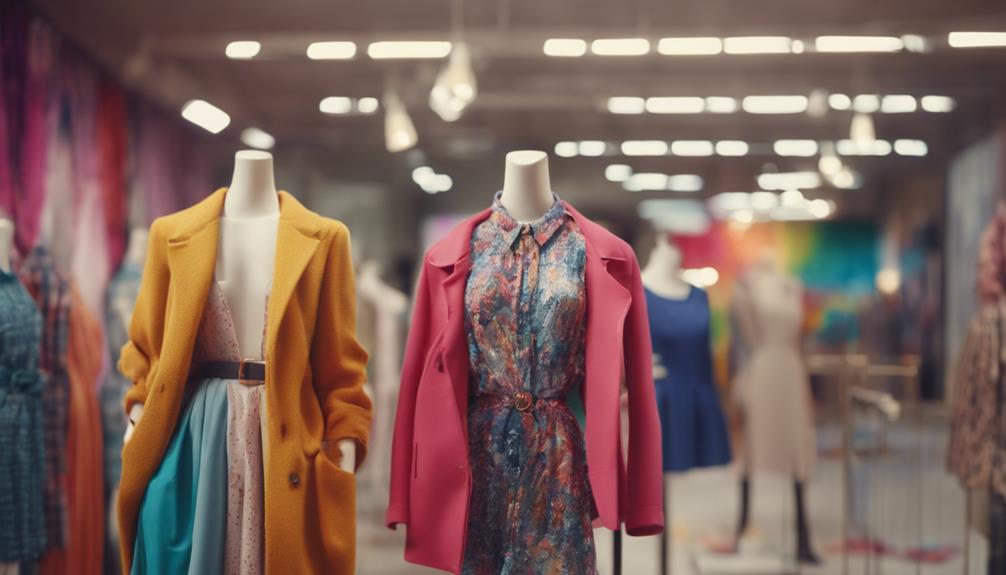
When you're on the hunt for fashion sketching supplies, focus on high-quality sketchbooks that can handle various media without ink bleed-through. Look for sketchbooks with a weight of at least 90 lb (200 gsm) to guarantee that your designs remain crisp and clear.
Your shopping guide should include a diverse array of sketching tools, such as fine liners, colored pencils, and watercolor brushes, which allow you to create different textures and effects in your work.
Consider investing in a digital drawing tablet like those from Wacom or Huion. These tools enhance your sketching experience with pressure sensitivity and customizable settings, making your designs more dynamic.
Don't forget to explore online marketplaces for curated kits. These often include essential materials like mixed media paper and shellac inks that add durability to your sketches.
As you shop, remember the importance of comfort. Ergonomic drawing tools, such as angled pencils or grips, can greatly improve your sketching sessions.
Upcycling Old Garments
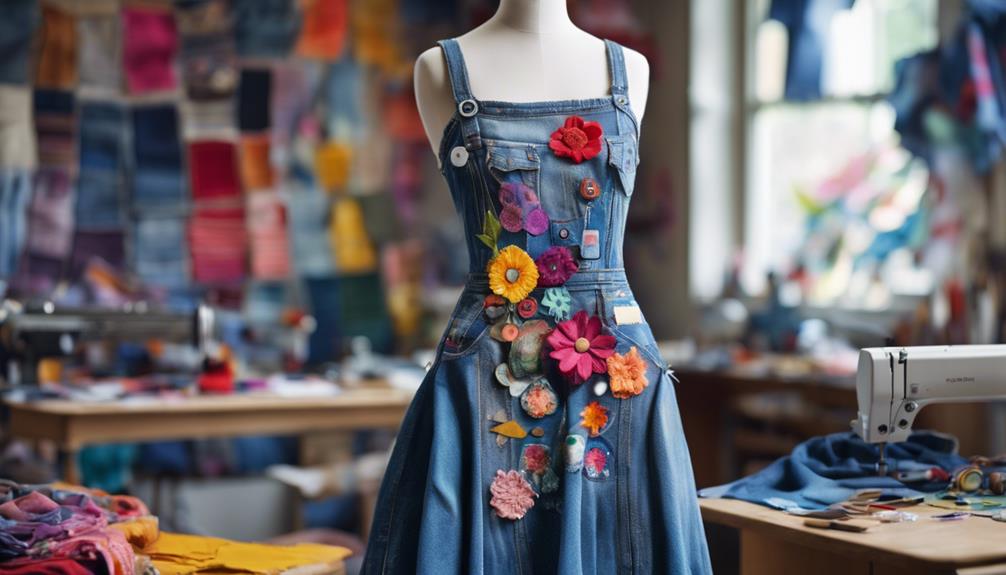
Upcycling old garments, like turning a worn-out denim jacket into a stylish statement piece, is a fantastic way to express your creativity.
You can explore patchwork design ideas that not only breathe new life into your clothing but also reduce waste.
Let's get into some fun ways to transform your wardrobe with these upcycling techniques!
Upcycled Denim Jacket Transformations
Transforming an old denim jacket into a unique fashion statement not only showcases your creativity but also supports sustainable practices in the fashion industry.
Upcycling this staple extends its life and greatly reduces textile waste. You can personalize your jacket using various creative techniques, like painting vibrant designs, adding fun patches, or embellishing with beads or studs.
If you want to modernize the fit, consider removing old pockets or tailoring the jacket for a more contemporary silhouette. This not only enhances wearability but also gives your piece a fresh look.
Plus, engaging in upcycling projects can help you develop new skills, like sewing and designing, as you innovate with existing materials.
Patchwork Design Ideas
Patchwork design offers a creative way to breathe new life into old garments by mixing and matching various fabric pieces to craft one-of-a-kind clothing items. By upcycling your wardrobe, you not only express your unique style but also contribute to sustainability by reducing textile waste. The fashion industry greatly impacts the environment, contributing around 10% of global carbon emissions, so every little effort counts.
You can start with popular patchwork techniques such as sewing together different fabric swatches or using appliqué to add texture. Incorporating embroidery can take your design to the next level, providing added detail and personality. As you explore patchwork design, you'll discover endless possibilities for individual expression.
Don't worry if you're new to this; there are plenty of online platforms and workshops that offer resources and tutorials, making it easy for you to engage with upcycling fashion. Whether you're a novice or an experienced designer, patchwork design invites you to curate a personalized aesthetic using colors, patterns, and textures from previously worn clothing.
Embrace your creativity and transform old garments into something fresh and fabulous!
Cultural Impact
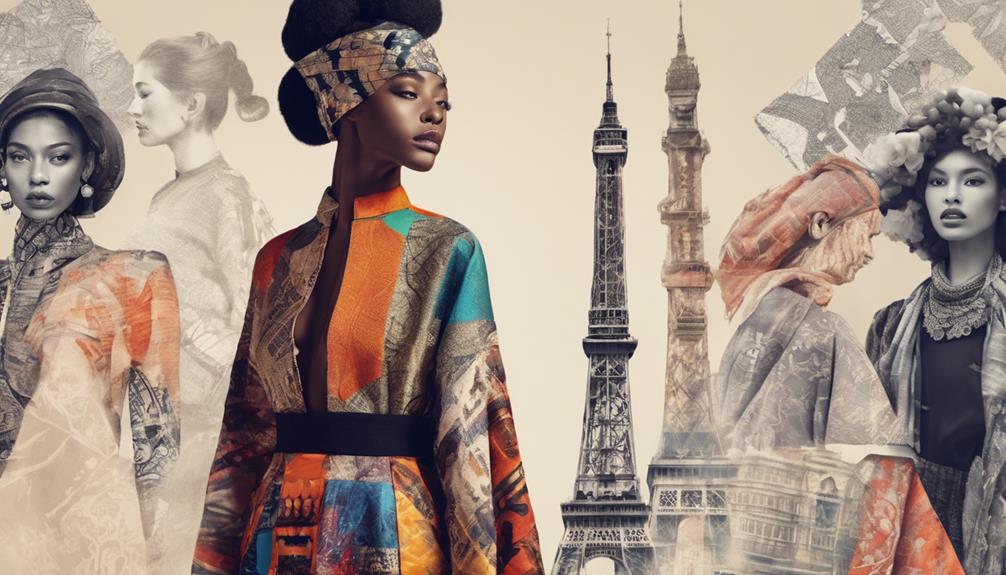
When you look at fashion sketches in music videos, you see how they shape and reflect cultural movements and trends.
Fashion activism also plays an essential role, as artists use their designs to raise awareness about social issues.
Together, these elements showcase the powerful connection between fashion and culture.
Fashion in Music Videos
Fashion in music videos shapes cultural narratives and trends, making it a powerful influence on both the fashion industry and societal norms.
When you watch your favorite artist flaunt their style, you tap into your inner fashion designer, inspired to emulate those looks. Music videos aren't just about the music; they serve as a platform for iconic fashion statements that can turn streetwear into mainstream trends. For instance, after Kanye West and Pharrell Williams showcased their unique styles, streetwear exploded in popularity.
The impact of these visuals is tangible, as seen when Britney Spears' 'Toxic' led to a significant rise in denim sales. Artists like Beyoncé and Lady Gaga challenge traditional gender norms through their fashion choices, promoting a message of inclusivity.
In addition, collaborations between designers and musicians, like Gucci and Balmain, create custom pieces that bridge high fashion and pop culture. This fusion also enhances the visibility of styles, encouraging fans to engage with and replicate these looks.
As you explore fashion in music videos, remember that it's not just about aesthetics; it's a cultural movement that invites you to express your unique style.
Fashion Activism and Awareness
In today's world, style isn't just about looking good; it's a powerful tool for activism that raises awareness about pressing social issues and drives cultural change. Fashion activism harnesses the influence of design and clothing to spark conversations and inspire action.
As a consumer, you play an essential role in this movement. With 75% of shoppers favoring brands committed to ethical practices, your choices can support sustainable fashion and encourage companies to adopt responsible methods.
Moreover, initiatives like the Fashion Revolution movement empower you to question the origins of your clothing. By asking, 'Who made my clothes?' you promote transparency and accountability in the industry.
The shift towards inclusivity and body positivity is another indication of fashion activism's impact, as over 80% of brands now showcase diverse models in their campaigns.
Fashion designers are increasingly addressing critical issues such as climate change, with 60% of companies embracing sustainability in their strategies. By engaging with these movements, you become part of a larger narrative—one that uses fashion as a vehicle for change and awareness.
Embrace your inner designer and let your style reflect your values!
Frequently Asked Questions
Why Is Sketching Important in Fashion Designing?
Sketching's essential in fashion design because it helps you visualize ideas, experiment with silhouettes, and communicate your concepts effectively. It boosts creativity and saves time, allowing you to refine designs before creating physical prototypes.
What Is a Drawing for Fashion Design Called?
A drawing for fashion design is called a fashion sketch or croquis. These sketches help you visualize your ideas, focusing on clothing details and exaggerated proportions to capture the movement and flow of your designs.
What Do You Mean by Fashion Designer?
A fashion designer's someone who creates clothing and accessories, blending creativity with technical skills. You'll research trends, sketch ideas, select fabrics, and develop prototypes, bringing unique styles to life that resonate with various audiences.
What Are the Benefits of Fashion Sketching for Unleashing Your Inner Designer?
Fashion sketching is a valuable tool to unleash your inner designer and bring your creative visions to life. It allows you to quickly transfer your ideas onto paper and experiment with different styles and details. Sketching also helps in refining your designs and communicating them effectively to others.
Can Fashion Dreamer Sketches Help Unleash Your Inner Designer?
Do fashion dreamer sketches have the power to unleash your inner stylist? Absolutely! By allowing you to freely explore your creative ideas and envision unique designs, fashion dreamer sketches can ignite your passion for fashion and help unleash your inner stylist, bringing your unique visions to life.
Conclusion
Now that you've explored the world of fashion sketches, it's time to release your creativity!
Remember, fashion is about expressing who you are, so don't hesitate to experiment and make it your own.
Whether you're shopping for new pieces or upcycling old favorites, let your imagination guide you.
Embrace the cultural influences around you, and have fun with your designs.
After all, the best style is the one that reflects your unique personality!
Happy designing!
